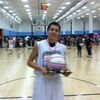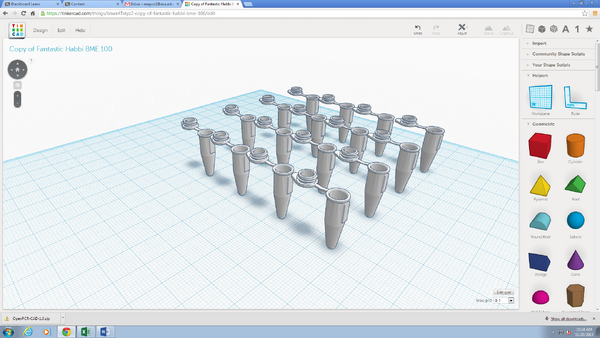BME100 f2013:W900 Group7 L6
| Home People Lab Write-Up 1 | Lab Write-Up 2 | Lab Write-Up 3 Lab Write-Up 4 | Lab Write-Up 5 | Lab Write-Up 6 Course Logistics For Instructors Photos Wiki Editing Help | ||||||
OUR COMPANY
PrimeTimeLAB 6 WRITE-UPComputer-Aided DesignTinkerCAD On November 20th, Tinkercad was used to redesign the PCR tubes. A twistable top was added so that the seal would be tighter and a labeling section was added where the tube can be labeled, thereby preventing any confusion. The number of PCR tubes was doubled so that more reagents and solutions could be mixed.
There are many ways to use Tinkercad to improve a product. It can be used to improve a PCR machine by printing out different designs for it so that biomedical engineers would be able to test and evaluate different designs to see which one is best before making the final product. Once 3D printing improves, it could be used to design and print out a PCR machine with different materials. That is how Tinkercad could be used to improve a PCR machine.
Feature 1: Cancer SNP-Specific PrimersBackground on the cancer-associated mutation Nucleotides are the building blocks of all DNA strands and RNA strands. Nucleotides are made up of a nitrogen base, a sugar, and a phosphate group, and the sequence of nucleotides determines the different proteins that are produced in translation. The four nucleotide bases that determine this sequence in DNA are adenine (A), thymine (T), guanine (G), and cytosine (C). A polymorphism occurs when different phenotypes exist in the same population of a species, so a single nucleotide polymorphism is when a single nucleotide differs between individuals in the same population. These SNPs can result in different diseases, such as cancer. In this test, the gene under investigation is rs17879961. This single nucleotide polymorphism is found in Homo sapiens (humans) and is located on the 22 pair of chromosomes (humans have 23 pairs of chromosomes). The clinical significance of this SNP is pathogenic, which means that is is capable of causing disease. The gene affected by this SNP is called CHEK2, which stands for checkpoint kinase 2. This gene encodes for a protein that is used at the second checkpoint of the cell cycle--when the protein is activated it prevents damaged cells from entering mitosis and proceeding through the cell cycle. However with this polymorphism, the protein could be damaged and therefore fail to stop damaged cells from entering and reentering the cell cycle uncontrollably, which causes cancer. . Primer design
How the primers work: The primers work by attaching to very specific segments of DNA. The primers can only bind to a sequence with complementary DNA. If a region does not contain complementary DNA, the primer will not be attached and transcription will not occur. Therefore primers are cancer-sequence specific because they will only bind to regions containing the cancer gene. After binding to the specific region, transcription occurs and the gene of interest is copied. This process continues as primers continue to only bind to the sequences of DNA containing the cancer causing gene, resulting in many copies of the cancer gene. If the cancer gene is not contained in a sequence, the primer will not attach to the region and transcription will not occur. Therefore, transcription will not occur for segments of DNA that do not contain a particular sequence and gene of interest and amplification of the sequence will not occur.
Feature 2: Consumables KitWithin our PCR consumables kit, the PCR tubes will have labels on the side that can be written on in order to keep track of the different types of primers, PCR mix, and sample DNA. In addition to labels on the tubes, a twistable cap will replace the old, hard to take off, slip on caps. This will provide maximum protection of PCR tube contents to keep from being contaminated from particles that could possible slip in and also prevent a possible cap to slip off on accident. There will also be a greater number of PCR tubes that come within our kit. The number of tubes will be doubled so that more tests will be able to run and thus speeding up the PCR process by running more tests at a time. As far as the shape of the PCR tubes, it is currently very effective in that it makes it very easy for the substance contained to be pipetted easily and effectively, thus changing the shape is unneeded. As far as changes to the micropipettor go, our groups' belief was that the micropipettor does a fantastic job at the tasks it was created to do and is a very effective tool in measuring small amounts of liquid and dispensing them in and out of the PCR tubes. One weakness that was noted in the virtual comment board powerpoint was the large amounts of waste that was created due to the inability to use micropipette tips after one use with a certain substance. This problem can be addressed by creating micropipette tips that have hydrophobic surfaces so that the liquids are dispensed in full, leaving no micro-drops of liquid and therefore contain no hints of a previous substance within the tip. This means that the tip will be able to be used multiple times without the need to throw away and exchange with a new tip, thus minimizing waste due to PCR experiments.
Feature 3: PCR Machine HardwareThe PCR machine within our product will function the same as the PCR machines used in previous labs. The PCR machine will come pre-assembled so that there is no user-error while trying to assemble the machine. The machine will be packaged safely and securely to prevent any damage to the machine. Also, an instruction sheet and software CD will be included with the machine. The instruction sheet will provide the user with easy to understand instructions on how to run the PCR test and the settings for the tests.
Feature 4: Fluorimeter HardwareThe inclusion of the fluorimeter in the system will remain the same for the most part as it is a vital component of the lab. For instance, slides with superhydrophobic surfaces and cohesive glass circles will still be provided, the fluorimeter will still have an LED light, a holder for the camera/phone will be provided, and an object to cover the fluorimeter will be included. However, few changes will be made to how these various parts of the fluorimeter are included in order to improve mobility and usability of the fluorimeter. For instance, the large, inconvenient box that is used to cover the fluorimeter when taking pictures of the PCR/ SYBR drop will no longer be provided, but rather a black cover made of flexible material, such as nylon or polyester, will be attached to the fluorimeter. The slides on which the drops are placed will be elongated so that they can be used to test more samples which prevents having to constantly replace slides when dealing with large numbers of samples. The LED light will be adjustable as well so that alignment of the PCR/ SYBR drop and the light can be more accurate. Finally, the holder for the camera/phone will be attached to the fluorimeter so that its position can be moved horizontally and vertically. In our system, two main design changes were made. The first pertains to the holder for the camera/phone. The holder would constantly move when taking pictures. As a result, the distance of the phone from the fluorimeter became a confounding variable because the distance between the phone and the fluorimeter was constantly changing. In order to remove this confounding variable, the holder will be attached to a rod connecting to the fluorimeter that can be adjusted both horizontally and vertically and tightened, thereby ensuring a constant distance between the phone and the fluorimeter. Another issue was that the phone would tilt and not stay perfectly perpendicular to the table; it would constantly move around, especially when taking pictures, causing some of the pictures to be blurred and unfocused. In order to solve this problem, the interior part of the holder will be made magnetic so that the phone will securely fit into the holder and assume an immovable, perfectly perpendicular state relative to the surface. The second change pertains to the color of the LED light. SYBR appears green because it is absorbing all of the visible light colors except for green and therefore has greatest absorbance and fluorescence at a color of light that is complementary to green. Therefore, the color of the LED light will be changed from blue to red because the greatest absorbance takes place at the wavelength of red light (620-780 nm), which is complementary to green light. All of these changes will ensure that the amount of fluorescence in the drops is measured more accurately and precisely.
Bonus Opportunity: What Bayesian Stats Imply About The BME100 Diagnostic ApproachIn the Bayesian statistics Calculation 3 shows the sensitivity of the patients' results, this describes the patients' probability of testing positive for the cancer disease. After doing all of the calculations the result for Calculation 3 was very small, showing that the PCR tests typically gave a false positive for the cancer disease. This means that the PCR machine was not reliable in matching a positive PCR result to a positive biopsy result. For Calculation 4 the specificity of the patients' results are found. Specificity is the patients' probability of testing negative for the cancer disease. The result we got was barely less than one, this means that the PCR testing was highly efficient in finding a negative result for the patients that correlated to a negative biopsy result. Due to the fact that the PCR machine gave out false positives so often the CHEK2 PCR system was not reliable, though it did often give the right negative test results. |
||||||






